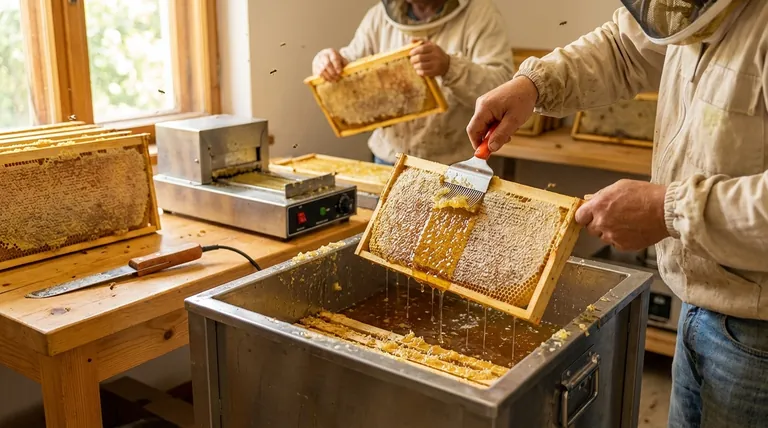Choosing the right uncapping method is a critical decision that directly impacts the efficiency and profitability of your honey harvest. Beekeepers must weigh several key factors: the initial cost of the equipment, the speed of the process, the physical impact on the wax comb, and the overall convenience for their scale of operation.
The ideal uncapping method is not a one-size-fits-all solution. It's a strategic choice that balances your budget, the number of hives you manage, and your goals for both honey and wax recovery.

Core Factors for Evaluating Uncapping Methods
Your choice of tool and technique will define your entire extraction workflow. Analyzing these four factors will clarify which approach best suits your apiary's needs.
Initial Cost vs. Long-Term Value
The financial investment can range from a few dollars for a simple manual tool to thousands for an automated machine.
While a low initial cost is attractive, you must consider the hidden cost of your time. A method that is slow or difficult to use may prove more "expensive" in the long run due to lost efficiency.
Speed and Throughput
The number of hives you manage is the most significant determinant here. A hobbyist with two hives has vastly different needs than a commercial operator with two hundred.
An efficient workflow is paramount for larger operations. The speed of uncapping must match the speed of your extractor to avoid bottlenecks in the honey house.
Impact on Comb and Wax Recovery
How a tool removes the cappings directly affects the integrity of the drawn comb. A gentle method preserves this valuable resource, saving the bees significant energy on the next nectar flow.
More aggressive methods may damage the comb but can maximize the amount of wax cappings you harvest. This wax can be a valuable secondary product.
Convenience and Workflow Integration
Consider the entire process from hive to bottle. Your uncapping method should be convenient and fit seamlessly into your setup.
This includes factors like ease of cleaning, the space required, and how effectively the tool works with your uncapping tank to collect honey that drips from the cappings.
Understanding the Trade-offs
Every uncapping method involves a compromise. Recognizing these trade-offs is key to making an informed decision.
Manual Methods: Low Cost, High Labor
Tools like uncapping forks and cold knives are inexpensive and give the beekeeper precise control.
However, they are also the slowest and most labor-intensive methods, making them suitable only for small-scale operations.
Heated/Electric Methods: A Balance of Speed and Cost
Heated electric knives and planes melt through the cappings, dramatically increasing speed over manual methods for a moderate investment.
The trade-off is a higher upfront cost and the need for a power source. They represent a common middle ground for serious hobbyists and sideliners.
Automated Machines: Maximum Throughput, High Cost
For commercial beekeepers, automated uncappers (like flail-style machines) are essential for processing hundreds of frames quickly.
The clear downside is the significant capital investment, which is unjustifiable for anyone other than a large-scale producer.
Making the Right Choice for Your Apiary
Select your method based on a realistic assessment of your goals and scale.
- If your primary focus is low-cost hobby beekeeping (1-10 hives): A simple uncapping fork or scratcher offers precision and control with minimal investment.
- If your primary focus is efficiency for a sideline business (10-50 hives): An electric uncapping knife provides a major speed advantage that justifies the moderate cost.
- If your primary focus is a high-volume commercial operation (50+ hives): An automated uncapping machine is a necessary investment to handle the workload and maximize throughput.
Ultimately, the best method is the one that seamlessly integrates with your workflow, respects your budget, and helps you achieve your specific harvesting goals.
Summary Table:
| Factor | Consideration | Key Question |
|---|---|---|
| Initial Cost | Investment vs. long-term value | Does the cost justify the time saved? |
| Speed | Frames processed per hour | Will it create a bottleneck in your workflow? |
| Comb Impact | Preservation of drawn comb | How does it affect wax recovery and bee labor? |
| Convenience | Integration with your honey house setup | How easily does it fit into your entire process? |
Ready to optimize your honey harvest? The right uncapping equipment is a direct investment in your apiary's profitability. At HONESTBEE, we supply commercial apiaries and beekeeping equipment distributors with high-performance, wholesale-focused uncapping solutions—from electric knives to automated machines—designed for durability and maximum throughput. Let our experts help you select the perfect tool for your scale and goals.
Contact HONESTBEE today for a personalized consultation and wholesale pricing!
Visual Guide

Related Products
- Professional Extra-Wide Uncapping Fork with Bent Tines for Beekeeping
- Stainless Steel Double Sided Honey Uncapping Fork with Scraper
- Wide Adjustable Stainless Steel Honey Uncapping Fork with Scraper
- Stainless Steel Dual Blade Uncapping Plane
- Extra Wide Stainless Steel Honey Uncapping Fork with Scraper Beekeeping Tool
People Also Ask
- How does comb depth affect the efficiency of uncapping tools? Match Your Tool for a Faster Harvest
- How should honeycombs be prepared for honey extraction? A Step-by-Step Guide to a Clean Harvest
- What are the essential tools for uncapping honey frames? Choose the Right Tool for Your Apiary
- How to uncap and extract honey? A Beekeeper's Guide to a Clean, Efficient Harvest
- What tools can be used to remove the beeswax capping? Choose the Right Tool for Your Harvest



















